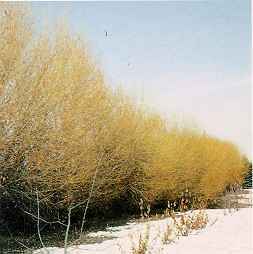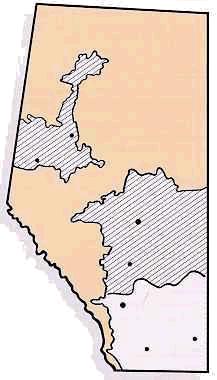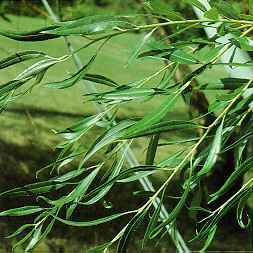| | Plant characteristics | Fall colour | Site preference | Hardiness | Uses | Problems | Diseases | Insects | Pruning
.

Scientific Name: Salix alba var vitellina (L) J. Stokes.
Plant Characteristics
Golden willow is distinguished by its shining golden twigs. The masses of bright golden yellow twigs are distinctly showy and may be considered as an ornamental asset to the winter scene. They are also used for wicker work and basketry.
This fast-growing, deciduous shrub or tree can grow to a mature height of 7 to 12 m (23 to 36 ft), with a spread of 9 m (30 ft). It has an annual growth rate of 50 to 150 cm (1.5 to 3.5 ft), and a useful lifespan of 25 to 60 years.
Leaves - Leaves are alternate, simple, narrow- lanceolate, long-acuminate, serrulate, glaucous beneath and slightly silky; 4 to 10 cm (1.5 to 4 in.) long.
Propagated by cuttings.
Fall Colour
Green leaves remain late into fall.
Site Preference
Golden willow can be planted in full sun or half shade. It likes moisture, but not poorly drained soil, and will not tolerate drought. It prefers organic soil, not recommended for grey-wooded soils, and will not tolerate alkaline soils.
Hardiness
Sensitive - might experience winter damage.
.


Uses
Golden willows are used for accent planting, parks planting, shelterbelts, and single-stemmed landscape plantings.
In shelterbelt situations this willow should be planted 2 to 4 m (6 to 13 ft) between trees in the row and 5 to 8 m (17 to 26 ft) between rows.
Problems
Performs poorly on arid sites.
Diseases
Moderately disease free.
Insects
Moderately insect free.
Pruning
When the tree is young, it can be pruned to a single straight trunk, but also grows multi-stemmed especially in shelterbelts.
.

Shelterbelts Varieties for Alberta provides information on a number of other trees and shrubs than may be suitable for shelterbelts.
Visit our website directory for the Reforestation Woodlot Listings.
|
|